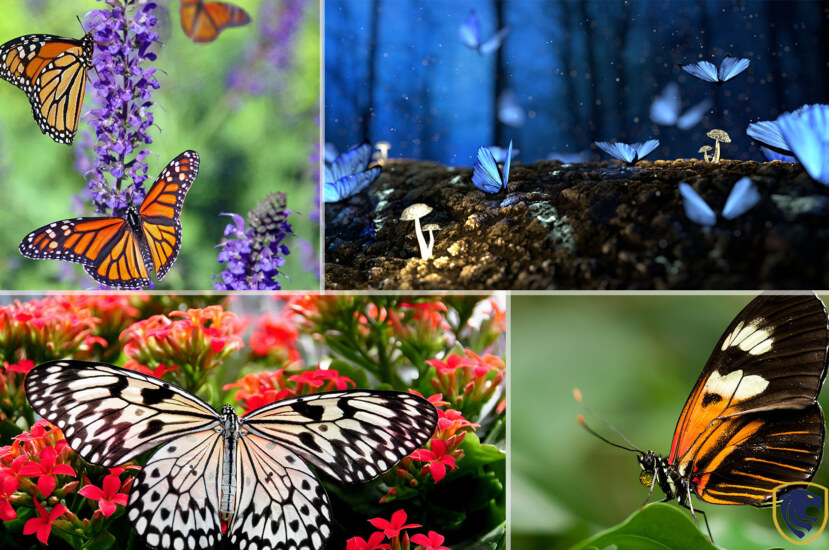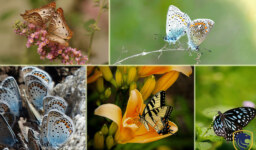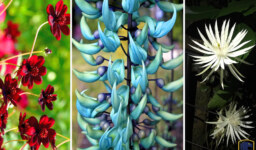Butterflies are beautiful creatures with vibrant colors and delicate wings. They come in a wide variety of shapes and sizes, captivating us with their graceful flight. Their wings are covered in tiny scales, giving them their unique patterns and colors. Butterflies undergo a transformation called metamorphosis, starting as eggs, then becoming caterpillars, and finally emerging as butterflies. They play an essential role in pollination, as they feed on nectar from flowers. The lifecycle of butterflies is a fascinating example of nature’s wonders, reminding us of the beauty and intricate processes that exist in the natural world.
The Blue Morpho
The Blue Morpho is scientifically known as Morpho peleides. It is a striking butterfly species renowned for its breathtaking beauty and vibrant blue wings. This species is native to the rainforests of Central and South America. The Blue Morpho butterflies have captivated the imagination of scientists, artists, and nature enthusiasts alike.
The Blue Morpho’s mesmerizing appearance is a result of structural coloration rather than pigmentation. The microscopic scales on its wings are designed to scatter and reflect light, producing an iridescent blue hue that seems to shimmer and change when viewed from different angles. This phenomenon, known as iridescence, is a visual masterpiece of nature.
Measuring around 5 to 6 inches in wingspan, the Blue Morpho is one of the largest butterfly species in the world. However, its size is not the only remarkable feature. When in flight, the Blue Morpho displays a fascinating behavior called “flash-and-freeze.” It alternates between rapid, dazzling flights, and brief moments of stillness, during which its bright blue wings remain closed, camouflaging it among the foliage.

The Blue Morpho
The Blue Morpho’s vivid coloring and distinctive flight pattern serve multiple purposes. While its beauty is undoubtedly an evolutionary advantage, it also acts as a defense mechanism. The flash of blue wings can startle predators, providing the butterfly with a chance to escape. Additionally, the stillness during flight freezes the butterfly’s image, making it difficult for predators to track its movement.
Due to their captivating appearance, Blue Morpho butterflies are highly sought after by collectors and butterfly enthusiasts. However, it is crucial to appreciate these magnificent creatures in their natural habitats and support conservation efforts to ensure their survival.
The Ulysses Butterfly
The Ulysses Butterfly, scientifically known as Papilio ulysses, is a stunning butterfly found in the rainforests of Australia and Papua New Guinea. With its vibrant blue wings and distinct black markings, the Ulysses Butterfly is a sight to behold. The male butterflies are more vividly colored than the females, displaying a rich, iridescent blue that seems to glow in the sunlight. Their wingspan can reach up to 5 inches, making them a relatively large butterfly species.

The Ulysses Butterfly
The Ulysses Butterfly is known for its swift and agile flight, gracefully navigating through the forest canopy. They feed on nectar from various flowering plants and play a vital role in pollination. The Ulysses Butterfly undergoes a complete metamorphosis, starting as an egg, then transforming into a caterpillar, and finally emerging as a butterfly. It is fascinating to witness this life cycle unfold in the natural world. Unfortunately, habitat loss and climate change pose significant threats to the Ulysses Butterfly’s survival. Conservation efforts are crucial to protect their habitats and ensure the continued existence of this remarkable butterfly species.
Monarch Butterflies
Monarch Butterflies, scientifically known as Danaus plexippus, are renowned for their exquisite beauty and captivating color combination. Found across North America, these butterflies possess striking orange wings with intricate black veins and borders. The vibrant orange hue of their wings is accentuated by the contrasting black, creating a visually stunning display.
Their wingspan typically ranges between 3.7 to 4.1 inches, making them a medium-sized butterfly species. However, their beauty transcends their size. What sets Monarch Butterflies apart is their unique pattern of black and white spots along the borders of their wings, adding an additional touch of elegance to their appearance.

Monarch Butterflies
Butterfly enthusiasts and nature lovers alike are captivated by the Monarch’s beauty. Their colorful wings are not merely aesthetically pleasing but also serve a purpose. Monarchs employ a phenomenon called aposematism, using their vibrant colors as a warning signal to predators that they are toxic. The caterpillars of Monarch Butterflies consume milkweed plants, which contain toxic substances that are retained in their bodies even as adults.
The Monarch Butterfly’s annual migration is another remarkable aspect of their biology. They undertake an incredible journey, covering thousands of miles from Canada and the United States to overwintering sites in Mexico and California. This migration is a breathtaking phenomenon, demonstrating the resilience and adaptability of these remarkable creatures.
However, Monarch Butterflies face numerous challenges, including habitat loss, pesticide use, and climate change. Conservation efforts are crucial to protect their habitats, conserve milkweed plants, and ensure the continued survival of this iconic butterfly species.
Sunset Moth
The Sunset Moth, scientifically known as Chrysiridia rhipheus, is a captivating butterfly species native to the island of Madagascar. Its beauty is truly mesmerizing, with an enchanting combination of vibrant colors that rival the hues of a stunning sunset. The wings of the Sunset Moth display a kaleidoscope of iridescent colors, including hues of green, blue, purple, and yellow. The colors seem to dance and shift as light reflects off the microscopic scales on their wings, creating a breathtaking display of iridescence.
What makes the Sunset Moth even more extraordinary is the intricate pattern on its wings. Delicate black lines and markings complement the vibrant colors, enhancing the overall elegance of this remarkable butterfly. The contrast between the vivid colors and the dark markings adds depth and definition, making it a true marvel of nature’s artistry.

Sunset Moth
The Sunset Moth’s wingspan ranges from approximately 3 to 4 inches, and both males and females exhibit similar coloration. However, the males are generally more vibrant and display a more extensive range of colors compared to the females. Their graceful flight, coupled with their stunning appearance, makes them a sight to behold.
Due to their captivating beauty and rarity, Sunset Moths are highly sought after by collectors and enthusiasts. However, it is crucial to appreciate these magnificent creatures in their natural habitat and support conservation efforts to protect their delicate ecosystems. Preserving the rainforests of Madagascar is vital for the continued existence of the Sunset Moth, ensuring future generations can marvel at its breathtaking beauty.
Resplendent Forester
The Resplendent Forester, scientifically known as Stichophthalma camadeva, is a butterfly species found in Southeast Asia. It is renowned for its exquisite beauty and striking color combination. The wings of the Resplendent Forester are adorned with a dazzling array of colors, including shades of deep blue, electric green, and vibrant orange. These colors blend harmoniously, creating a captivating and resplendent display.
The wings of the Resplendent Forester feature intricate patterns and designs that add to its allure. Delicate black lines and markings contrast with vibrant colors, enhancing the overall elegance of this butterfly. The combination of the vivid hues and the detailed patterns makes the Resplendent Forester a true gem in the insect world.

Resplendent Forester
With a wingspan of approximately 2.5 to 3 inches, the Resplendent Forester is a relatively small butterfly. However, its beauty and grace make a lasting impression. The delicate flight of this species adds to its enchantment as it flutters through its natural habitat.
The Resplendent Forester’s captivating appearance makes it a sought-after species among collectors and nature enthusiasts. However, it is essential to appreciate these beautiful creatures in their natural environment. Also, we should support conservation efforts to protect their habitats. Preserving the diverse ecosystems of Southeast Asia is crucial for the continued existence of the Resplendent Forester, ensuring that its breathtaking beauty can be admired for generations to come.
Dragontail Butterflies
Dragontail Butterflies, scientifically known as Lamproptera curious, are a fascinating and captivating species found in parts of Southeast Asia. Renowned for their unique beauty, Dragontail Butterflies possess a mesmerizing color combination and distinct wing shape.
The wings of Dragontail Butterflies are translucent, with delicate scales that give them a glass-like appearance. They have a distinctive elongated shape, resembling the tail of a dragon, which adds to their allure. The coloration of the wings varies depending on the angle of light and the individual, but they often feature a combination of iridescent greens, blues, and purples. These colors seem to shimmer and change as the butterfly flutters through the air, creating a magical spectacle.
One of the most striking features of Dragontail Butterflies is the “tail” on their hindwings. These elongated projections resemble wisps of smoke or tendrils, adding an ethereal quality to their appearance. The tails are believed to serve a purpose in deterring predators by mimicking the antennae of the butterfly and confusing potential threats.

Dragontail Butterflies
With a modest wingspan of around 2 to 3 inches, Dragontail Butterflies are relatively small in size. However, their delicate and intricate features make them stand out in the butterfly world. Their slender bodies and graceful flight further enhance their beauty, as they effortlessly navigate through their natural habitats.
Due to their unique and captivating characteristics, Dragontail Butterflies are highly prized among butterfly enthusiasts and collectors. However, it is essential to appreciate these enchanting creatures in their natural habitats and support conservation efforts to protect their ecosystems. Preserving the biodiversity-rich regions of Southeast Asia is crucial to ensure the continued existence of Dragontail Butterflies, allowing future generations to marvel at their breathtaking beauty.
The Glasswing Butterfly
The Glasswing Butterfly, scientifically known as Greta oto, is a remarkable and ethereal species found in Central and South America. It is renowned for its unique beauty and transparent wings, which give it the appearance of delicate, glass-like panes.
The wings of the Glasswing Butterfly lack the vibrant pigmentation seen in many other butterfly species. Instead, they are transparent, with only subtle hints of color along the edges. This transparency allows the butterfly to blend seamlessly into its surroundings, making it appear almost invisible at times. The Glasswing Butterfly’s wings have a delicate iridescent quality, reflecting and refracting light as it passes through them, resulting in a stunning display of shimmering hues.

The Glasswing Butterfly
Though predominantly transparent, the Glasswing Butterfly’s wings are adorned with delicate black veins and markings. These intricate patterns create a striking contrast against the transparent backdrop, adding depth and definition to its ethereal beauty.
With a wingspan of approximately 2.5 to 3 inches, the Glasswing Butterfly is of medium size. Moreover, its slender body and long, thin wings give it a graceful appearance. The delicate flight of the Glasswing Butterfly further enhances its ethereal allure as it glides through the air, almost weightless and seemingly invisible.
The transparent wings of the Glasswing Butterfly serve a purpose beyond their aesthetic appeal. Also, they provide the butterfly with a natural form of camouflage, allowing it to blend in seamlessly with flowers and foliage. This unique adaptation helps protect the butterfly from predators, as it can evade detection and potential harm.




